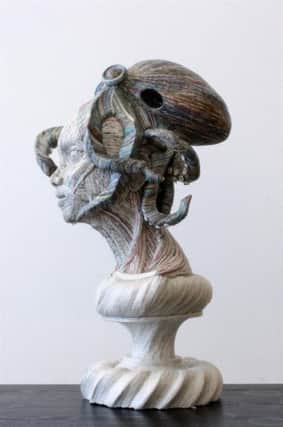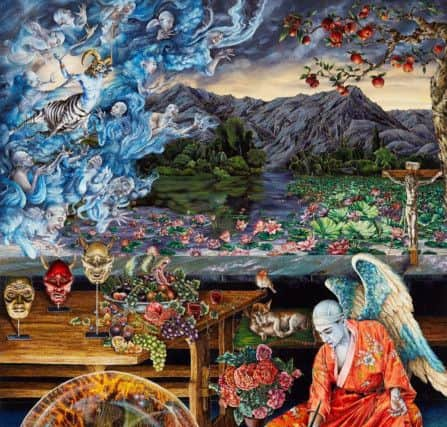Art reviews: RSA Open Exhibition | Raqib Shaw: Reinventing the Old Masters


RSA Open Exhibition, Royal Scottish Academy, Edinburgh ****
Raqib Shaw: Reinventing the Old Masters, Scottish National Gallery of Modern Art, Edinburgh **
I don’t know if it is a case of FHB –family hold back – but the academicians taking part are not numerous. Some of those who have done so have chosen tiny works, too. David Mach for instance has a miniature collage called S**tload. I don’t know if it is a wry comment on the political situation in the Middle East, but it shows a camel driver whose camel is staggering under a load of cut-out comic book words for explosive noises: Blam, Bang, Crash etc. Nearby, Glen Onwin’s Blue on Black Above Below is a small essay in intensity of colour. Jacki Parry, Henry Kondracki, Alfons Bytautis and Paul Furneaux are amongst the other academicians showing. Philip’s Table by Parry is an eloquent watercolour a tribute to the late Philip Reeves, so long an outstanding ornament of the RSA and other group exhibitions. Kondracki is always happy on a small scale and his High Summer is a characteristic Edinburgh scene of light and shade in the Meadows. Bytautis is represented by an intriguing abstract drawing called About Face and Furneaux’s Spring Flowers is a lovely woodcut in his usual Japanese manner.


Advertisement
Hide AdJo Ganter served as convener for the show and so it is to her that credit should go for its spare elegance. She has contributed an appropriately spare and elegant drawing, a cubist composition in pencil against light ochre washes. Arthur Watson, president of the Academy, is represented by a screen print, Order and Chaos. Order is green against red and blue. Chaos is blue against red and green, but otherwise they seem remarkably similar.
The bulk of this open submission show is, appropriately, by non-academicians and here too the quality is high. Barry McGlashan’s Flemish Painter, a 16th century artist is making his way through a snowy landscape carrying the tools of his trade, is a lovely tribute to Bosch and Brueghel. Roland Fraser’s work is familiar, but that doesn’t diminish the impact of his lovely white relief in salvaged wood, Drummohr. Robert Powell is another old favourite in these shows. His print, The Golden Rump, a multi-figured composition with some details worthy of Georg Grosz, is a dyspeptic variation on the idea of Hesiod’s Golden Age. Among those whose work is less familiar, Heather Bell’s Untitled (pillow) is strikingly surreal, a glass eye gazing out of folded cloth in the form of a pillow. Very different, but perhaps also surreal is Bathtub Existentialism by Joao Villas. You look down into what seems to be a small bathtub from which the water is perpetually draining away. Rituals and Repetitions by Oana Stanciu is another intriguing film work in which, using mirror images, a figure goes through an series of metamorphoses.
Lammermuir by Soosan Dannesh is a glowing abstract composition in layered colours apparently inspired by the East Lothian hills. Michael Waight’s Landscape with Oculus is also an abstract landscape, but realised in an assemblage of delicately painted wood. More overtly a landscape but clearly inspired by abstraction is The light of patience by Fi Wallace Velarde. A combination of monotype and carborundum print, with minimal means, but quite beautifully, it sets a boat against the sea and setting sun. Autumn Pickings by Astrid Trügg is a straightforward still life of a chair, fruit and a basket, but in a cool graphic register reminiscent of Eric Ravillious and none the worse for that.
Among the sculpture, a lively looking sandstone rabbit is by Giles Heffer and a very striking portrait of Alasdair Gray by John Ferguson stand out. The latter is described as a book sculpture and is indeed made of books and paper.
There are also some fine prints. Bryan Angus’s linocut, Ogilvie Street, uses a traditional technique to great effect. Tracy McCoey’s Traffic is also a fine example of traditional etching techniques. Dunstanburgh by Jack Whitewell is a dramatic print in photogravure and there are also some very fine photographs using more conventional printing methods. Field Fence, Aberdeenshire, by David Baker, North Sea Dip by Euan Ross and Out-running the blizzard by Siljes Elisabet Torin are three particularly beautiful examples.
Altogether there is much to admire at the RSA. I am not sure that you can say the same about Raqib Shaw at the Scottish National Gallery of Modern Art. His show is subtitled Reinventing the Old Masters. Cranach’s beautiful Allegory of Melancholy has, for instance, been brought along and hung beside his variation, or travesty, of the picture. Noel Paton’s Quarrel of Oberon and Titania has also been brought for the same treatment and indeed in the catalogue all his pictures are paired with some unfortunate Old Master. I am afraid seeing this work in the National Gallery suggests that the age of fake news and post-truth is also the age in which we have lost sight of the difference or even the possibility of there being any difference between good art and bad art. (I got the same feeling in Grayson Perry’s RA.) But let’s ignore fashion. This is definitely bad art. Indeed, whatever the subtitle may claim, as art these pictures have less to do with the Old Masters than a National Gallery fridge magnet. It is hard to describe them, but there is something really unpleasant and also gratuitous about the way that in them grotesque detail is piled on grotesque detail, fruit, fungi, snakes, animals, demons and much else, all highly finished and with a horrid shiny surface. It is like some awful nightmare of an overdecorated Victorian town hall in Hell, but in cheap ceramic – there is nothing of the richness of surface the Victorians achieved, or would have achieved even in Hell. The pictures actually made me feel slightly sick. If the artist gets marks for his effort, and that cannot be denied, he does not get many for his art.
RSA Open Exhibition until 25 July; Raqib Shaw until 28 October